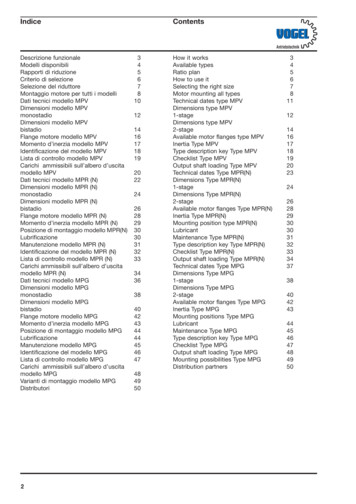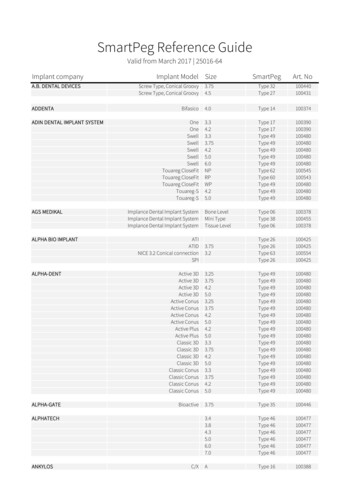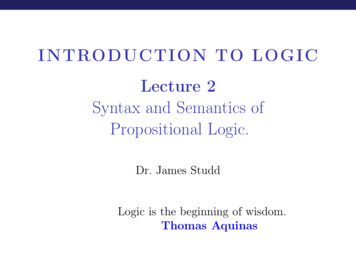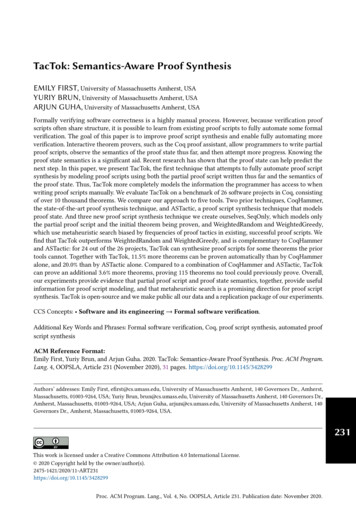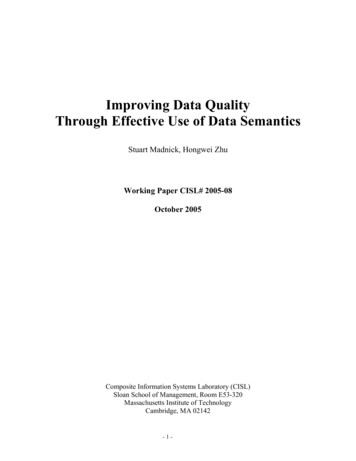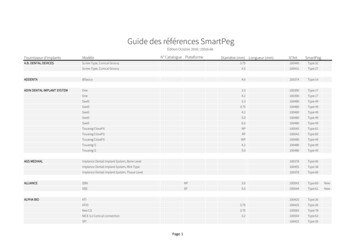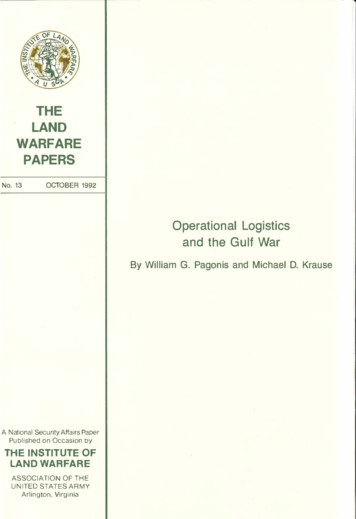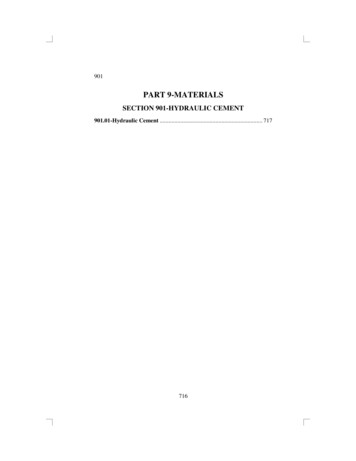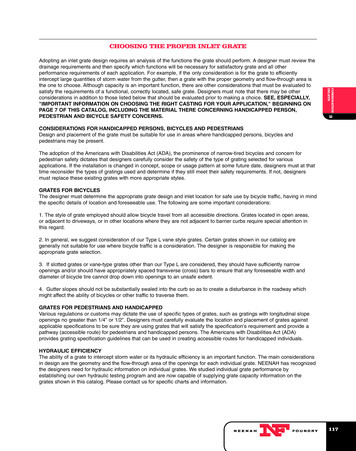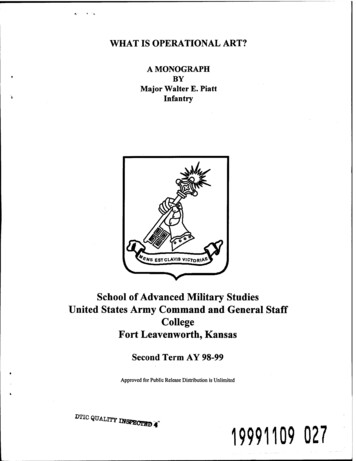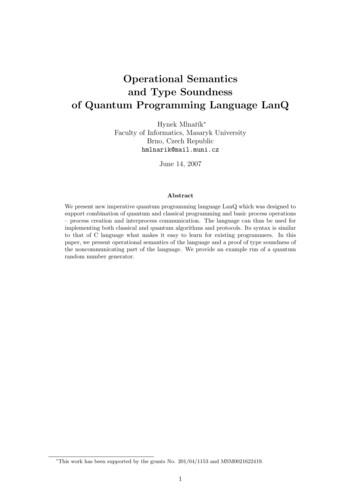
Transcription
Operational Semanticsand Type Soundnessof Quantum Programming Language LanQHynek Mlnařı́k Faculty of Informatics, Masaryk UniversityBrno, Czech Republichmlnarik@mail.muni.czJune 14, 2007AbstractWe present new imperative quantum programming language LanQ which was designed tosupport combination of quantum and classical programming and basic process operations– process creation and interprocess communication. The language can thus be used forimplementing both classical and quantum algorithms and protocols. Its syntax is similarto that of C language what makes it easy to learn for existing programmers. In thispaper, we present operational semantics of the language and a proof of type soundness ofthe noncommunicating part of the language. We provide an example run of a quantumrandom number generator. This work has been supported by the grants No. 201/04/1153 and MSM0021622419.1
CONTENTSCONTENTSContents1 Introduction42 Informal introduction53 Concrete syntax64 Internal syntax65 Typing5.1 Typing rules . . . . . . . . . . . . . . . . . . . . . . . . . . . . . . . . . . . . .996 Basic concepts6.1 Notation . . . . . . . . . . . . . . . . . . . . . . . . . . . . . . . . . . . . . . .6.2 Reference-related concepts . . . . . . . . . . . . . . . . . . . . . . . . . . . . .6.3 Variable-related concepts . . . . . . . . . . . . . . . . . . . . . . . . . . . . .131313147 Operational semantics7.1 Memory model . . . . . . . . . . . . . . .7.2 Variable properties storage . . . . . . . .7.3 Configuration . . . . . . . . . . . . . . . .7.4 Variable properties handling functions . .7.5 Local memory handling functions . . . . .7.6 Functions for handling aliasfor constructs7.7 Internal values . . . . . . . . . . . . . . .7.8 Transitions . . . . . . . . . . . . . . . . .7.9 Runtime errors . . . . . . . . . . . . . . .7.10 Processes and configurations . . . . . . . .7.10.1 Structural congruence . . . . . . .7.10.2 Nondeterminism and parallelism .7.11 Evaluation . . . . . . . . . . . . . . . . . .7.11.1 Basic rules . . . . . . . . . . . . .7.11.2 Promotable expressions . . . . . .7.11.3 Allocation . . . . . . . . . . . . . .7.11.4 Variable declaration . . . . . . . .7.11.5 Assignment . . . . . . . . . . . . .7.11.6 Block . . . . . . . . . . . . . . . .7.11.7 Conditional statement – if . . . . .7.11.8 Conditional cycle – while . . . . .7.11.9 Method call . . . . . . . . . . . . .7.11.10 Returning from a method . . . . .7.11.11 Forking . . . . . . . . . . . . . . .7.11.12 Measurement . . . . . . . . . . . .7.11.13 Communication . . . . . . . . . . .7.12 Rule index . . . . . . . . . . . . . . . . . 63738398 Type soundness8.1 Typing of configurations . .8.2 Progress . . . . . . . . . . .8.3 Type preservation . . . . .8.3.1 Evaluation theorems.4040424444June 14, 2007, 18:19.2.
CONTENTS8.4CONTENTS8.3.2 Type preservation lemmata . . . . . . . . . . . . . . . . . . . . . . . .Type soundness . . . . . . . . . . . . . . . . . . . . . . . . . . . . . . . . . . .53639 Conclusion and future work63A Program execution example66June 14, 2007, 18:193
11INTRODUCTIONIntroductionQuantum computing is a young branch of computer science. Its power lies in employing quantum phenomena in computation. These laws are different to those that rule classical world:Quantum systems can be entangled. Quantum evolution is reversible. One can computeexponentially many values in one step.Quantum phenomena were successfully used for speeding up a solution of computationallyhard problems like computing discrete logarithm or factorisation of integers [Sho94]. Anothersuccessful application of quantum phenomena in computing, namely in cryptography, is securequantum key generation [BB84, Eke91, Ben92]. Quantum key generation overcomes theclassical in the fact that its security relies on the laws of nature, while classical key generationtechniques rely on computational hardness of solving some problems. A nice example ofquantum phenomena usage is a teleportation of an unknown quantum state [BBC 93].For the formal description of quantum algorithms and protocols, several quantum programming languages and process algebras have already been developed. Some of them support handling quantum data only, however most of them allow combining of quantum andclassical computations. Obtaining classical data from quantum systems is done by measurement which is probabilistic by its nature. This implies that quantum formalisms must be ableto to handle probabilistic computation.Existing formalisms are usually based on existing classical programming languages andprocess algebras. From imperative languages, we should mention Ömer’s QCL (QuantumComputation Language, [Öme00]) whose syntax is based on that of C language; Betteli,Calarco and Serafini’s Q language built as an extension of C basic classes [BCS01]. However, semantics of these imperative languages is not defined formally. Zuliani’s qGCL (quantum Guarded Command Language, [Zul01]) based on pGCL (probabilistic Guarded CommandLanguage) has denotational semantics defined but does not support recursion.Many of developed languages are functional because of relatively straightforward definitionof its operational semantics. Van Tonder developed a quantum λ-calculus [vT03]; quantumλ-calculus was also developed by Selinger and Valiron [SV05]; Selinger proposed functionalstatic-typed quantum flow-chart programming language QFC and its text form QPL [Sel04].Another functional programming language QML was developed by Altenkirch and Grattage[AG04] and refined into nQML in [LGP06].Quantum process algebras differ to classical ones in the way they handle quantum systems.The main issue solved here is that they must guarantee that any quantum system is accessibleby only one process at one time (because of the no-cloning theorem [WZ82]). The quantumprocess algebras QPAlg by Lalire and Jorrand [LJ04, JL04, Lal05] and CQP by Gay andNagarajan [GN04, GN05, GN06] can describe both classical and quantum interaction andevolution of processes. QPAlg was inspired by CCS, originally using nontyped channels forinterprocess communication. Recently [Lal06], Lalire has added support for fixpoint operatorand typed channels to QPAlg.The presented language LanQ is an imperative quantum programming language. It allows combination of quantum and classical computations to be expressed. Moreover, it hasfeatures of quantum process algebras – it supports new process creation and interprocesscommunication. Its syntax is similar to the syntax of C language. In the present paper, wedefine its syntax, operational semantics, and prove type soundness of the noncommunicatingpart of the language.The paper is structured as follows: we start with an example of an program written inLanQ in Section 2. We then formally define its concrete (Section 3) and internal syntax(Section 4). Then basic concepts used later in the paper are defined in Section 6, followed bytyping system in Section 5.1. In Section 7, we define the operational semantics of the languageJune 14, 2007, 18:194
2INFORMAL INTRODUCTIONand prove its type soundness in Section 8. An example of a simple program execution can befound in Appendix A.2Informal introductionWe begin our description of LanQ by an example implementation of a well-known multipartyquantum protocol – teleportation [BBC 93]. Teleportation can be written as the programshown in Figure 1.void main() {qbit ψA , ψB ;ψEP R aliasfor [ψA , ψB ];channel[int] c withends [c0 , c1 ];int bert(channelEnd[int] c1 , qbit stto) {int i;i recv (c1 );if (i 0) {opB0 (stto);} else if (i 1) {opB1 (stto);} else if (i 2) {opB2 (stto);} else {opB3 (stto);}doSomethingElse(stto);return i;ψEP R createEPR();c new channel[int]();fork bert(c0 , ψB );angela(c1 , ψA );}void angela(channelEnd[int] c0 , qbit ats) {int r;qbit φ;}φ doSomething();r measure (BellBasis, φ, ats);send (c0 , r);}Figure 1: Teleportation implemented in LanQWe now briefly describe the program. In LanQ, a program is a set of methods. Threemethods, main, angela and bert, are defined. The control is passed to a method calledmain() when the program is run. This method takes no parameters and it returns no valuewhat can be seen from the word void in front of the method name. The method angela() hasto be invoked with two parameters – one end of a channel that can be used to transmit valuesof type int, and one qubit (ie. a quantum bit). It also returns no value. The method bert()takes a channel end and a qubit, and returns a value of type int.The method main() declares variables ψA , ψB , ψEP R , c, c0 and c1 used in the method bodyin its first three lines: The type of variables ψA , ψB is qbit. Variable ψEP R is declared to be analias for a two-qubit compound system ψA ψB . Channel c capable of transmitting integersis declared on the next line. The ends of the channel are named c0 and c1 .On next lines, the method main invokes method createEPR() which creates an EPR-pair,and stores the returned reference to the created pair into the variable ψEP R . After that, anew channel is allocated and assigned to the variable c. This also modifies the channel endvariables c0 and c1 . The next command makes the running process split into two. One of theprocesses continues its run and invokes the method angela(). The second process starts itsrun from the method bert().The method angela() receives one channel end and one qubit as arguments. After declaringvariables r and φ, it assigns a result of invocation of a method doSomething() to φ. Then itmeasures qubits φ and ats using the Bell basis, assigns the result of the measurement to thevariable r and sends it over the channel end c0 .June 14, 2007, 18:195
4INTERNAL SYNTAXThe method bert() receives one channel end and one qubit as arguments. After declaring avariable i, it receives an integer value from the channel end c1 and assigns it to the variable i.Depending on the received value, it applies one of the operators opB0 , opB1 , opB2 and opB3on qubit stto. Then, it invokes a method doSomethingElse() and passes the variable stto asan argument to this method. Finally, it returns the value of the variable i to the caller.3Concrete syntaxIn this section, we introduce concrete syntax of LanQ programs. This syntax is used to writeprograms by a programmer. Semantics is defined using internal syntax which is describedlater (see Section 4).The syntax is shown in Figure 3. Reserved words of the language are written in boldand the identifier names are in capitals. Grammar is given in nondeterministic extendedBackus-Naur form (EBNF). The root of grammar is the nonterminal program.For the sake of clarity, the concrete grammar nonterminals names are long and descriptive to indicate their meaning. We describe meaning of the most important nonterminals here: program (words derived from this nonterminal represent LanQ programs), code(statements), pExpr (promotable expressions, ie. expressions that can act as statements),methodCall (method calls), methodP arams (method parameters), assignment (assignments),measurement (measurements), expr (expressions), indivExpr (individual expressions, ie. expressions not containing any operators), op (operators), method (method declarations), block(blocks of code), seq (block-forming statements, ie. statements that can be used in blocks),and varDeclaration (variable declarations). The other nonterminals are auxiliary and theirmeaning is obvious.Definition 3.1. Let m be a method declaration. We call the part of m which was derivedfrom nonterminal methodHeader a method header, and the part of m which was derivedfrom nonterminal block a method body.In the following example, a method named mN ame is declared. The parts of the methoddeclaration are annotated on the right side.T mN ame(T1 a1 , . . . , Tn an ){. statements .}} method headermethod body Figure 2: Declaration of a method named mN ame4Internal syntaxIn this section, we define the internal syntax of LanQ.Using the concrete syntax, a LanQ program is written as a set of method declarations.This notation does not allow direct execution of the program. To define operational semantics,we need a representation for the program execution – a syntax that allows us to evaluate aprogram by means of rewriting of program terms. The rewriting rules are presented later inSection 7 where the operational semantics is defined.June 14, 2007, 18:196
4INTERNAL SYNTAXCodeprogramcodepExpr:: method :: ; pExpr; f ork send return block if while:: assignment methodCall recv measurement new nonDupT ype()methodCall:: methodName ( (methodP arams)? )methodP arams :: expr (, expr) assignment:: variableName exprmeasurement:: measure ( basisName (, variableName) )expr:: indivExpr (op expr)?indivExpr:: const variableName ( expr ) pExprop:: – . . .Block structuremethodblockseqmethodHeadermethodDeclP aramListmethodDeclP aramvarDeclaration:: :: :: :: :: :: :: methodHeader block{ (seq)? }varDeclaration (seq)? code (seq)?type methodName ( methodDeclP aramList? )methodDeclP aram(, methodDeclP aram) nonV oidT ype paramNamenonV oidT ype variableName(, variableName) ; channelT ype variableName withends[ variableName , variableName ] ; variableName aliasfor[ variableName (, variableName) ] ;Program flowf ork:: fork methodCall ;return :: return (expr)? ;Conditionals and loopsif:: if ( expr ) code (else code)?while :: while ( expr ) codeCommunicationrecv :: recv ( expr )send :: send ( expr , expr ) ;TypestypenonV oidT ypedupT ypenonDupT ypechannelT ypeqT ypeqBasicT ype:: :: :: :: :: :: :: void nonV oidT ypedupT ype nonDupT ypeint bool . . .channelEnd[nonV oidT ype] channelT ype qT ypechannel[nonV oidT ype]qBasicT ype( qT ype)?qbit qtrit . . .Figure 3: Concrete syntaxThe internal syntax is defined in Figure 4. The syntax is similar to the concrete one whilenot containing declarative parts of the concrete syntax and being abbreviated. In the internalsyntax, we define the following basic syntactic entities: numbers (N ), lists (L), recursive lists(RL), references (R), constants (C), identifiers (I), types (T ), and internal values (v).June 14, 2007, 18:197
4INTERNAL SYNTAXPromotable expressions (P E) are expressions that can act as statements when postfixedby semicolon. Expressions (E) can evaluate to an internal value. The syntactic classes ofvariable declarations (V D) and statements (S) can together create a block. Therefore theyare together called block-forming elementary statements (Be). A block-forming statement (B)is built from zero or more such block-forming elementary statements.Remark 4.1. For the sake of clarity, we use the following notation in the rule body. We dee an abbreviation of “(E (, E) )?”.note by S̄ an abbreviation of BNF rule body “(S) ”, and by E0 1 .e][] [NgL [RL]none (Classical,N ) (Quantum,RL) (Channel,N ) (ChannelEnd0 ,N ) (ChannelEnd1 ,N ) (GQuantum,L) (GChannel,N )R true false . . .x y z . .void int qbit channel[T ] channelEnd[T ] T T . . .hhR, CiiTNLRLR:: :: :: :: CITv:: :: :: :: PEEVDSe measure(E)e recv(E)new T () I E I(E)I v (E) P Ee channel[T ] I withends[I,I]; I aliasfor [I];eT I;; P E; {B} if (E) S else S while (E) S e send(E,E);return; return E; fork I(E);:: V D S:: BeBeB:: :: :: :: Figure 4: Internal syntaxConfiguration syntax specifies formal notation of process configuration which is describedin Subsection 7.3.If a statement or an expression contains a subexpression, this subexpression is evaluatedseparately and the evaluation result is substituted in place of the subexpression. For this reason, we introduce a concept of a hole ( ) which stands for the awaited result of subexpressionevaluation. We call a term not containing a hole a closed term.The terms containing a hole are defined by nonterminals Sc and Ec which representpartially evaluated statements and expressions, respectively, whose subexpression is beingevaluated. In other words, they represent evaluation contexts. We also define syntacticentities for runtime errors (RT Err) and term stack elements (StkEl).Before a method can be invoked to be run, we must transform its body to the internalrepresentation. Fortunately, the method bodies derived using concrete syntax and internalsyntax rules differ only in the following: In internal representation, all if statements have else part, ie. a statement if (E) P isrewritten to if (E) P else ;, In internal representation, all constants C are represented by internal values hhnone, CiiTwhere T is the type of the constant C, In internal representation, all operators are written in the prefix notation and seen asmethod calls, ie. EF is converted to (E,F ).June 14, 2007, 18:198
5TYPINGe measure(ee recv( )Ec:: I I(ev, ,E)v, ,E)e send( ,E); return ;Sc:: ; if ( ) S else S fork I(ev, ,E);RT Err :: UV OQV ISQVStkElLM SVP:: B E Ec Sc RT Err L M:: local memory state as described in Subsection 7.3:: variable properties as described in Subsection 7.3LSP:: (LM S,V P ,StkEl):: LS LS k P I]):: ((DM ,L),[I GSSysU nivwhere DM is a density matrix:: [GS P ]:: p Sys p Sys U nivFigure 5: Configuration syntaxThere is obviously an algorithm which rewrites any method body derived using the concrete syntax to the internal representation.An example of a block written using the concrete syntax and its internal representationis shown in Figure 6.{{int r;qbit φ;int r;qbit φ;φ doSomething();r measure (BellBasis, φ, ats);send (c0 , r);if (r 0) {measure (StdBasis, φ);}φ doSomething();r measure (BellBasis, φ, ats);send (c0 , r);if ( (r, 0)) {measure (StdBasis, φ);} else ;}}(a)(b)Figure 6: Block derived using concrete syntax (a) and the same block converted to internalsyntax (b).5Typing5.1Typing rulesLanQ is a typed language. This feature enables us to detect errors arising from incorrectusage of methods, variables and constants at compile time.First, we define basic types used in LanQ: void (a type with only one value: ), int (atype of integers), bool (a type of truth values true and false), Qn (a type of references ton-dimensional quantum systems), Ref (a type of references, defined later in Subsection 7.1),RTErr (a type of runtime errors), and MeasurementBasis (a type of measurement bases).1 IfT is a type, then channel[T] is a type of references to a channel capable of transmitting values1The type system can be indeed extended when needed.June 14, 2007, 18:199
5.1Typing rules5TYPINGof type T, and channelEnd[T] is a type of references to ends of such a channel. Further, letS1 , ., Sn , S be types for n 0. Then a method type T is defined to be the type S1 , S2 , ., Sn S. We call types S1 , . . . , Sn argument types and the type S a return type.Definition 5.1. We define a set T ypes of types of classical values. We denote by val(T) aset of values of type T and define a set V alues as a set of values of all types:[V alues val(T).T T ypesAfter parsing a program, the method declarations are stored in a triplet (MT , MH , MB )of partial functions. We call this triplet a method typing context where: MT (m) which returns the method type for a method m (the method type is straightforwardly determined from the method header), MH (m) returns the method header for a method m, and MB (m) which returns the method body represented using internal syntax for a methodm.We provide typechecking rules in Figures 7, 8, 9 and 10. These rules use a typing contextwhich is a pair (M ; Γ) consisting of: M is a method typing context, Γ is a variable typing context – a partial mapping Γ : N ames * T ypes that assigns atype to a variable name. We write a variable typing context Γ as Γ a1 : T1 , . . . , an : Tnmeaning that the type Ti is assigned to the variable ai .The extension of a context Γ by a variable b of type Tb is written as Γ, b : Tb . It isundefined if Γ(b) is defined and Γ(b) 6 Tb . Otherwise it is defined as:(Tbif x b,(Γ, b : Tb )(x) Γ(x) otherwise.Let P be a program whose internal representation is stored in a method typing context(MT , MH , MB ). We call this program well-typed if the premise of the rule T-Program issatisfied for this method typing context. This check is passed iff all the declared methodssatisfy the typing rule T-Method.Typechecking of a method in the rule T-Method is a little more complicated. The reasonis that we require any method m whose return type is not void to return a value of appropriatetype in all possible control paths which the evaluation of this method can take. The returntype is for the sake of typechecking stored in the formal variable @retV al.This can be checked at compile time. We split this requirement into two:(1) during evaluation, the method m body always reaches a return statement (or invokesa runtime error or diverges), and(2) any value returned by a return statement during evaluation of the method m body is ofappropriate type. This is checked by typing rules T-ReturnVoid and T-ReturnExprin cooperation with T-Method.For formal definition of the condition (1), we define a predicate RetOk.June 14, 2007, 18:1910
5.1Typing rules5TYPING m dom(MT ) : (MT , MH , MB ) T MH (m) : MT (m) (MT , MH , MB )T-ProgramT void RetOk(MB (m)),(MT , MH , MB ); a1 : T1 , . . . , an : Tn , @retV al : T T MB (m) : void(MT , MH , MB ) T T m(T1 a1 , . . . ,Tn an ) : T1 , . . . , Tn TT-MethodFigure 7: Typing rules for program and method declarationT-VarDeclT-VarDeclChET-VarDeclAlFM ; Γ, I0 : T, . . . , In : T T B : TM ; Γ T T I0 , . . . ,In ;B : TM ; Γ, I0 : channel[T ], I1 : channelEnd[T ], I2 : channelEnd[T ] T B : TM ; Γ T channel[T ] I0 withends [I1 ,I2 ];B : T i {1, . . . , n}N: M ; Γ T Ii : Ti where Ti is a quantum type,M ; Γ, I0 : ni 1 Ti T B : TM ; Γ T I0 aliasfor [I1 , . . . ,In ];B : TFigure 8: Typing rules for variable declarationsT-SkipM ; Γ T ; : voidT-PromoExprM ; Γ T P E : TM ; Γ T P E; : voidT-BlockM ; Γ T B : voidM ; Γ T {B} : voidT-BlockHeadT-IfT-WhileM ; Γ T Be0 : void M ; Γ T Be1 . . . Ben : voidM ; Γ T Be0 Be1 . . . Ben : voidwhere Be0 6 V DM ; Γ T E : bool M ; Γ T S0 : void M ; Γ T S1 : voidM ; Γ T if (E) S0 else S1 : voidM ; Γ T E : bool M ; Γ T S : voidM ; Γ T while (E) S : voidT-ReturnVoidM ; Γ, @retV al : void T return; : voidT-ReturnExprM ; Γ, @retV al : T T E : TM ; Γ T return E; : voidT-Forke : T I is a classical methodM ; Γ T I(E)e : voidM ; Γ T fork I(E);T-SendM ; Γ T E0 : channelEnd[T] M ; Γ T E1 : TM ; Γ T send(E0 , E1 ); : voidFigure 9: Typing rules for statementsJune 14, 2007, 18:1911
5.1Typing rules5TYPINGM ; Γ, I : T T I : TT-VarM ; Γ T hhR, CiiT : TT-ValueT-BracketM ; Γ T E : TM ; Γ T (E) : TT-AllocT is either a quantum type (Qd ) or a channel type (channel[T])M ; Γ T new T() : TT-AssignM ; Γ, I : T T E : TM ; Γ T I E : TT-MethodCallT-MeasurementMT (I) S0 , . . . , Sn T M ; Γ T E0 : S0 . . . M ; Γ T En : SnM ; Γ T I(E0 , . . . ,En ) : Twhere M (MT , MH , MB )M ; Γ T E0 : MeasurementBasis, i {1, . . . , n} : M ; Γ T Ei : Ti where Ti is a quantum typeM ; Γ T measure(E0 ,E1 , . . . ,En ) : intM ; Γ T E : channelEnd[T]M ; Γ T recv(E) : TT-RecvFigure 10: Typing rules for expressionsDefinition 5.2. Let B be a block-forming statement. We define a predicate RetOk as: true RetOk(St ) RetOk(Se ) WRetOk(B) Bei RetOk(Bei ) RetOk(B 0 ) falseif B return E;if B if (E) St else Seif B Be0 Be1 . . . Benif B { B 0 }otherwiseThis predicate does not handle the case B while (E) S because evaluation of thecondition E is undecidable at compile-time. Hence even for the straightforwardly alwaysterminating case B while (true) return 1;, RetOk(B) is not satisfied. Therefore thepredicate is only approximate.Later we prove a lemma stating that if the predicate RetOk is satisfied on B then anycontrol path of evaluation of B reaches a return; or return E; statement, or a runtime error,or diverges (see Lemma 8.15). Thus, if B is a method m body and RetOk(B) is satisfied,the evaluation of method can either reach some return statement, lead to a runtime error,or diverge.Definition 5.3. We call a method m well-typed if the premises of rule T-Method aresatisfied for this method.Remark 5.4. Note that if a method m is well-typed and its return type is not void then itsbody contains only return E; statements, ie. no return; statements.The rest of the typing rules is usual: The rules for typechecking variable declarations inFigure 8 check the block-forming statement can be typechecked with the variable contextextended with the newly declared variables.June 14, 2007, 18:1912
6BASIC CONCEPTSWe formally regard all statements to be of type void what is seen in the typechecking rulesin Figure 9. These rules are quite usual up to the rule T-Fork. This rule requires that themethod, which should be a new process run from, is classical. This is natural requirementas running a new process, which is by its nature a classical object from a quantum operator,would be a nonsense.The typechecking rules for expressions shown in Figure 10 are designed as usual.6Basic conceptsBefore we continue with formal definition of the semantics, we must define several usefulfunctions and structures. First we define notation used in the rest of the article.6.1NotationNotation 6.1. Let S be a set, / S. Then S S { }. We denote a set of naturalnumbers with zero N {0} by N0 .Definition 6.2. Let S be a set. An S-list s [s1 , . . . , sn ] is a list where n N0 ands1 , . . . , sn S. Set of all finite S-lists {s s is a finite S-list} is denoted by S[] .Definition 6.3. Let m, n N0 . Let L [l1 , . . . , ln ], K [k1 , . . . , km ] be lists. Then L is a length of a list L, L n. Concatenation of lists L and K is defined as L · K [l1 , . . . , ln , k1 , . . . , km ]. Set of list L elements is defined as set(L) {l1 , . . . , ln }.6.2Reference-related conceptsWe use the following specially formed lists for storing references to quantum systems.Definition 6.4. Let S be a set. We define a recursive S-list recursively as: Any S-list [s1 , . . . , sk ] is a recursive S-list, A list [e1 , . . . , em ] is a recursive S-list for any m N0 if e1 , . . . , em are recursive S-lists.For example, [[[1, 2, 3], [2, 3]], [1]] and [] are recursive N-lists.Recursive S-lists are used for the representation of quantum system references in thefollowing way:A reference to a quantum system, be it compound or not, is specified by a recursive Nlist. Quantum systems are stored in indexed registers in the quantum memory, one quantumsystem per one register. The (unique) index is assigned to a quantum system when it isallocated. The reference to the system with index n is a recursive N-list [n].Let us have two quantum systems φ and ψ whose indices are 1 and 2, respectively. Thereferences to these quantum systems are rφ [1] and rψ [2], respectively. A reference to acompound system ρ consisting of the two quantum systems φ and ψ is then a recursive N-listrρ [rφ , rψ ] [[1], [2]]. Note that the structure of ρ, ie. that it consists of two systems,corresponds to the structure of the reference rρ – it is built up from two elements.Notation 6.5. The set of all finite recursive S-lists {s s is a finite recursive S-list} is denoted by S[ ] .Recursive S-lists allow us to nicely capture quantum system structure in the reference.However, when working with referred quantum systems, eg. applying some unitary operator,we do not want to bother with the structure – we only need a list of indices of the affectedquantum systems. To get such a linearized list out of the structured one, we define thefollowing function:June 14, 2007, 18:1913
6.3Variable-related concepts6BASIC CONCEPTSDefinition 6.6. For a recursive S-list s S[ ] , we define a function linearize : S[ ] S[]which converts a recursive S-list into an S-list:deflinearize(s) s if s S[]deflinearize([e1 , . . . , em ]) linearize(e1 ) · . . . · linearize(em ) where e1 , . . . , em S[ ]If a reference R contains a special element which denotes a reference to nonexistentquantum system, we consider the reference R itself to refer to nonexistent quantum system.Hence linearization of such a reference returns :Definition 6.7. For a set S , we define a function linearize : (S )[ ] (S )[] { } as:(linearize(s) [s1 , . . . , sn ]linearize (s) defif si 6 for all 1 i notherwiseDefinition 6.8. Let S be a set. We define a function set[ ] : S[ ] S for getting the set ofdefrecursive list items regardless of the structure as set[ ] (l) set(linearize(l)). We also definefunction [ ] : S[ ] N for getting length of a recursive list regardless of the structure asdef l [ ] linearize(l) .6.3Variable-related conceptsWe use partial functions to capture variable properties, eg. mapping a variable name to aplace in memory where the variable value is stored, or a mapping to the variable type. Wedefine several useful functions for handling these partial functions describing variables.Adding a new variable to a set of known variables is represented by extending the domainof the appr
Quantum evolution is reversible. One can compute exponentially many values in one step. Quantum phenomena were successfully used for speeding up a solution of computationally . Existing formalisms are usually based on existing classical programming languages and process algebras. From imperative languages, we should mention Omer's QCL .
